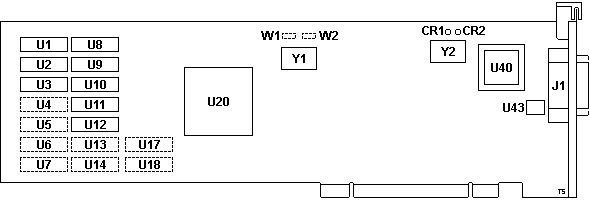|
@8007.ADF Vermont Microsystems Page Manager 100
Vermont Graphics System Combines Processor, Monitor (InfoWorld, 29 Aug 1988)
Page Manager 100
Experiences
Most of the information presented here came from Michal Necasek's blog post.
Page Manager 100 "Model 212"
![Front [P]](/other/img/photo.gif)
![Front (alt) [P]](/other/img/photo.gif)
![Connector [P]](/other/img/photo.gif)
![i82786 [P]](/other/img/photo.gif) (photos from Michal Necasek)
(photos from Michal Necasek)

CR1,2 LED, purpose unknown
J1 Video connector
U1-3,8-12 TMS 4464-12NL 64Kx4 DRAM
U4-7,13,14,17,18 pads for extra DRAM
U20 Intel A82786 Graphics co-pro
|
U40 Brooktree Bt454KPJ RAMDAC
U43 LM393N Dual comparator
W1,2 pads for 3-pin jumper
Y1 20 MHz osc (i82786)
Y2 102.5 MHz osc (RAMDAC)
|
J1 Video connector similar in
construction to 13W3, but with space for only 3 coax pins (RGB) and 5 regular
pins (8W5?). Since this is a monochrome adapter, only the middle coax (G) is
populated. The plug retention mechanism is also rather unusual. See
HERE.
Note: This is an AVE adapter, no VGA support
on-board.
Video Memory
The card uses 64Kx4 DRAM chips. 8 devices are populated by default (model
212) for 256 KB of video memory total. There are solder pads for another 8
devices, giving 512 KB of video memory when fully populated.
Intel 82786 Graphics Coprocessor
82786 CHMOS Graphics Coprocessor Datasheet
M82786 CHMOS Graphics Coprocessor Datasheet (Military)
82786 Graphics Coprocessor User's Manual
AP-259 Architectural Overview
AP-270 Hardware Configuration
Experiences
(source)
George Matsukis said:
You are looking at VMI's Page Manager Graphics card designed to
run at 76 kHz/70 Hz offering a monochrome 1024x1024 resolution. NECHE (Itasca,
IL) produced the paper white monochrome monitor.
David Ressler said:
George is correct. The Page Manager was produced as a high-end
simulated paper background black and white display intended for word processing
applications. The dual frequencies handled European standards at the time. It
was built for both retail and OEM sales and as OEM, it was used as the display
portion of other products. The product came into stress because color was very
interesting at that time in the market and although this ultra high resolution
(for the day) B/W display was a dream to look at, the cost was also high enough
that someone could purchase color at less-but-adequate resolution. The
connector was custom, as it came paired with the monitor that George mentions
above. The age of this board is between 1987 and 1990. In 1990, we had
remaining 1000 cards and the color video resolution in the market at that time
made it difficult to find a home for those cards and monitors. Original
designers of this equipment are now top-level technical executives at Nvidia
and I'm certain they have the original specs somewhere.
Robert Glennon said:
I worked for VMI for 7 years. That board was an OEM board that was
designed to work with a desktop publishing system software and a specific funky
portrait monitor. It was a Cambridge MA company, I think Leaf Systems? The
project was a bust, and I objected to its development. VMI was a small company
& in my opinion this was a deviation from VMI core strengths. The old
"stick to your knitting" thing. I had sales responsibility for the North East.
Computer Vision was a biggie.
|